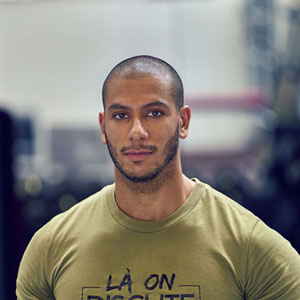Comment calculer ses besoins caloriques
Lorsqu’on cherche à transformer son physique, on sait à quel point de bons programmes de musculation et diététiques sont importants. Pour optimiser les résultats, il faut être autant attentif à l’un qu’à l’autre et structurer ses programmes de façon à ce qu'ils soient les plus cohérents possibles. Pour la musculation, cela veut dire qu’il faut bien choisir ses exercices, les exécuter le mieux possible, porter attention au nombre de séries et au nombre de répétitions. En bref, ne rien laisser au hasard.
Pour la diététique, c’est la même histoire. Il faut être en mesure de connaître son apport et ses besoins caloriques et de les modifier en fonction de ses objectifs. Mais si tu n’as aucune idée de ce que sont les apports et les besoins caloriques, alors je vais t’éclairer !
Ton apport calorique désigne la quantité de nourriture que tu consommes chaque jour. Il est mesuré en kilocalories (kcal) ou en joules (J) et regroupe la consommation des trois macronutriments que tu connais peut-être :
- les protéines
- les glucides
- les lipides
Chaque aliment t'apporte donc une quantité de calories ou de joules. Pour le riz basmati par exemple, c’est environ 350 kcal pour 100gr. Pour le blanc de poulet, c’est plus ou moins 110 kcal pour 100gr. Lorsque ces aliments s’ajoutent, ils constituent ton apport calorique journalier. C’est cet apport qui va déterminer si tu vas prendre, maintenir ou perdre du poids. Bien sûr, la quantité de macronutriments a son importance également, mais nous en discuterons peut-être dans un prochain article.
Mais, parce que oui il y a un mais, cet apport calorique journalier est obligatoirement à mettre en relation avec tes besoins caloriques journaliers. Connaître la quantité de calories que tu consommes chaque jour ne va pas t'emmener bien loin si tu ne sais pas ce dont tu as besoin. Il faut donc, en plus de connaître son apport, pouvoir calculer ses besoins caloriques. Pour cela, tu as différentes solutions à disposition.
Calculer ses besoins caloriques via l’expérimentation
Voilà une méthode qui ne se base sur aucune formule mathématique et qui a, en plus, le mérite d’être précise ! Il faut juste avoir un peu de patience et faire preuve d’organisation. Tout ce dont tu as besoin est d’une balance pour te peser chaque semaine et une balance pour peser tes aliments. Le principe est tout simplement de comparer ton apport calorique à l’évolution de ton poids. Sur une période d’une semaine, tu pèses tout ce que tu manges pour établir un total calorique précis.
Si au moment de la pesée tu as perdu du poids, c’est que ton apport calorique est en dessous de tes besoins. Tu es donc en déficit, ce qui peut être intéressant lorsque tu veux perdre du gras. Si au contraire tu as pris du poids, c’est que tes apports sont supérieurs à tes besoins, parfait lors d’une prise de muscle.
Le seul problème de cette méthode, c’est qu’il faut prévoir trois à quatre semaines pour arriver à déterminer précisément quels sont tes besoins en fonction de l’évolution de ton poids de corps. L’avantage, c’est qu’une fois le poids stabilisé, tu sais exactement ce dont tu as besoin.
Calculer ses besoins caloriques grâce à des formules mathématiques
De nombreux chercheurs ont développé des formules qui sont en général relativement précises et permettent d’avoir une bonne base de travail potentiellement ajustable pour avoir les meilleurs résultats possible. Aucune formule ne pourra te donner un résultat précis à 100%, la seule façon de calculer ses besoins caloriques avec une précision maximale est de passer 24h avec un masque respiratoire mesurant la quantité de CO² que tu expulses chaque minute…
Pas très pratique ! Ceci dit, c’est une méthode qui existe et qui est pratiquée dans la recherche scientifique. Mais pour le grand public, il est quand même plus simple de s’en remettre à ces équations plus accessibles. Voici les deux les plus populaires et, à mes yeux, les plus précises :
BMR = Basal Metabolic Rate (métabolisme de base)
P = Poids en kg
T = Taille en cm
A = Âge
L’équation de Mifflin St-Jeor
Pour les hommes
BMR = 10P + 6.25T - 5A + 5
Pour les femmes
BMR = 10P + 6.25T - 5A - 161
L’équation de Harris-Benedict
Pour les hommes:
BMR = 13.397P + 4.799T - 5.677A + 88.362
Pour les femmes:
BMR = 9.247P + 3.098T - 4.330A + 447.593
Le résultat de ces équations ne suffit pas à établir tes besoins caloriques précisément. Le BMR (métabolisme de base) n’est que l’estimation de la quantité de calories que tu consommes hors activité physique ! Il faut alors multiplier ce chiffre par un coefficient d'activité pour prendre en compte tout ce qui est susceptible de “brûler des calories”.
Ce coefficient d’activité est le suivant :
BMR x1,1 = Sédentaire, pas d’activité physique
BMR x1,2 = Activité physique légère une à deux fois par semaine
BMR x1,3 = Activité physique modérée trois à quatre fois par semaine
BMR x1,4 = Activité physique modérée quotidienne
BMR x1,5 = Activité physique intense six à sept fois par semaine
Tu obtiens donc avec ces formules une estimation de ton TDEE (Total Daily Energy Expenditure) qui est la quantité totale d'énergie que tu dépenses en une journée, toutes activités confondues. Tu as donc une idée précise de tes besoins caloriques.
Exemple pour un homme de 25 ans, de 180cm pesant 78kg et pratiquant la musculation six jours sur sept.
BMR avec l’équation de Mifflin St-Jeor = (10x78) + (6.25x180) - (5x25) + 5 = 1785 kcal
1785kcal x 1,5 = 2677 kcal
Avec ce résultat, cet homme de 25 ans devra consommer environ 2700 kcal pour maintenir son poids de corps. S’il veut prendre du poids (et du muscle), il devra consommer plus de 2700 kcal pour être en surplus calorique. Au contraire, s’il veut perdre du poids (et du gras) il devra consommer moins de 2700 kcal pour être en déficit calorique.
Bien sûr, ces résultats sont des estimations. Même s’ils sont, en général, relativement précis, tu devras sûrement les adapter légèrement en fonction de ta propre évolution. L’avantage d’utiliser ces formules, c’est qu’elles te permettent d’avoir une base de travail et de ne pas naviguer “à l’aveugle” lorsque tu cherches à atteindre un objectif. La plupart des applications disponibles sur smartphone s’occupent de faire le calcul à ta place. Tu peux tout à fait t’en remettre à ton application préférée pour établir tes besoins caloriques. Par précaution, tu peux aussi faire le calcul de ton côté et comparer les deux pour avoir plus de ressources utilisables.
“Ce qui peut être mesuré peut être contrôlé”
Comme pour l’entraînement, plus tu auras d’informations à disposition, plus tu auras de facilités à mesurer ta progression. Et ça, je peux te garantir que ça te fera gagner beaucoup de temps ! Je regrette encore de ne pas avoir calculé mes besoins caloriques plus tôt dans ma pratique de la musculation. Ce n’est que début 2011, quatre ans et demi après avoir commencé ce sport, que je me suis sérieusement mis à calculer mes apports et mes besoins. Et c’est à ce moment-là que j’ai progressé le plus rapidement.
Donc, fais de même pour exploser le plus vite possible tes objectifs ! Bon courage ;)
 Offre spéciale : Les 4 premières semaines à 19€
Offre spéciale : Les 4 premières semaines à 19€




